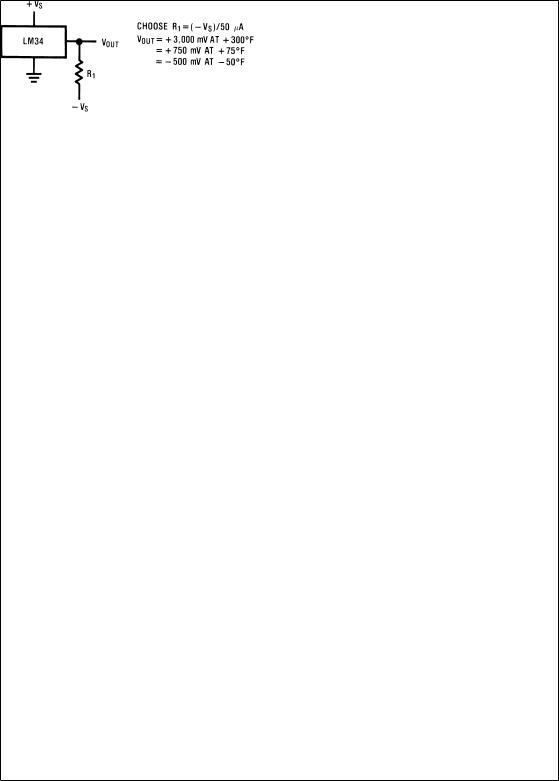National Semiconductor LM34, LM34A, LM34C, LM34CA, LM34D Technical data

LM34
September 1998
LM34/LM34A/LM34C/LM34CA/LM34D
Precision Fahrenheit Temperature Sensors
General Description
The LM34 series are precision integrated-circuit temperature sensors, whose output voltage is linearly proportional to the Fahrenheit temperature. The LM34 thus has an advantage over linear temperature sensors calibrated in degrees Kelvin, as the user is not required to subtract a large constant voltage from its output to obtain convenient Fahrenheit scaling. The LM34 does not require any external calibration or trimming to provide typical accuracies of ±1¤2ÊF at room temperature and ±11¤2ÊF over a full −50 to +300ÊF temperature range. Low cost is assured by trimming and calibration at the wafer level. The LM34's low output impedance, linear output, and precise inherent calibration make interfacing to readout or control circuitry especially easy. It can be used with single power supplies or with plus and minus supplies. As it draws only 75 µA from its supply, it has very low self-heating, less than 0.2ÊF in still air. The LM34 is rated to operate over a −50Ê to +300ÊF temperature range, while the LM34C is rated for a −40Ê to +230ÊF range (0ÊF with improved accuracy). The LM34 series is available packaged in
hermetic TO-46 transistor packages, while the LM34C, LM34CA and LM34D are also available in the plastic TO-92 transistor package. The LM34D is also available in an 8-lead surface mount small outline package. The LM34 is a complement to the LM35 (Centigrade) temperature sensor.
Features
nCalibrated directly in degrees Fahrenheit
nLinear +10.0 mV/ÊF scale factor
n1.0ÊF accuracy guaranteed (at +77ÊF)
nRated for full −50Ê to +300ÊF range
nSuitable for remote applications
nLow cost due to wafer-level trimming
nOperates from 5 to 30 volts
nLess than 90 µA current drain
nLow self-heating, 0.18ÊF in still air
nNonlinearity only ±0.5ÊF typical
nLow-impedance output, 0.4Ω for 1 mA load
Connection Diagrams
TO-46
Metal Can Package
(Note 1)
DS006685-1
Order Numbers LM34H,
LM34AH, LM34CH,
LM34CAH or LM34DH
See NS Package
Number H03H
Note 1: Case is connected to negative pin (GND).
TO-92
Plastic Package
SO-8
Small Outline
Molded Package
DS006685-2
Order Number LM34CZ,
LM34CAZ or LM34DZ
See NS Package |
DS006685-20 |
|
N.C. = No Connection |
||
Number Z03A |
||
Top View |
||
|
||
|
Order Number LM34DM |
|
|
See NS Package Number M08A |
TRI-STATE® is a registered trademark of National Semiconductor Corporation.
Sensors Temperature Fahrenheit Precision LM34/LM34A/LM34C/LM34CA/LM34D
© 1998 National Semiconductor Corporation |
DS006685 |
www.national.com |

Typical Applications
DS006685-3
FIGURE 1. Basic Fahrenheit Temperature Sensor
(+5Ê to +300ÊF)
DS006685-4
FIGURE 2. Full-Range Fahrenheit Temperature Sensor
www.national.com |
2 |

Absolute Maximum Ratings (Note 11)
If Military/Aerospace specified devices are required, please contact the National Semiconductor Sales Office/ Distributors for availability and specifications.
Supply Voltage |
+35V to −0.2V |
Output Voltage |
+6V to −1.0V |
Output Current |
10 mA |
Storage Temperature, |
|
TO-46 Package |
−76ÊF to +356ÊF |
TO-92 Package |
−76ÊF to +300ÊF |
SO-8 Package |
−65ÊC to +150ÊC |
ESD Susceptibility (Note 12) |
800V |
Lead Temp. |
|
TO-46 Package |
|
(Soldering, 10 seconds) |
+300ÊC |
TO-92 Package |
|
(Soldering, 10 seconds) |
+260ÊC |
SO Package (Note 13) |
|
Vapor Phase (60 seconds) |
215ÊC |
Infrared (15 seconds) |
220ÊC |
Specified Operating Temp. Range (Note 3) |
|
|
TMIN to TMAX |
LM34, LM34A |
−50ÊF to +300ÊF |
LM34C, LM34CA |
−40ÊF to +230ÊF |
LM34D |
+32ÊF to +212ÊF |
DC Electrical Characteristics (Notes 2, 7)
|
|
|
LM34A |
|
|
LM34CA |
|
|
|
|
|
|
|
|
|
|
|
|
|
Parameter |
Conditions |
|
Tested |
Design |
|
Tested |
|
Design |
Units |
|
|
Typical |
Limit |
Limit |
Typical |
Limit |
|
Limit |
(Max) |
|
|
|
(Note 5) |
(Note 6) |
|
(Note 5) |
|
(Note 6) |
|
|
|
|
|
|
|
|
|
|
|
Accuracy (Note 8) |
TA = +77ÊF |
±0.4 |
±1.0 |
|
±0.4 |
±1.0 |
|
|
ÊF |
|
TA = 0ÊF |
±0.6 |
|
|
±0.6 |
|
|
±2.0 |
ÊF |
|
TA = TMAX |
±0.8 |
±2.0 |
|
±0.8 |
±2.0 |
|
|
ÊF |
|
TA = TMIN |
±0.8 |
±2.0 |
|
±0.8 |
|
|
±3.0 |
ÊF |
Nonlinearity (Note 9) |
TMIN ≤ TA ≤ TMAX |
± 0.35 |
|
± 0.7 |
± 0.30 |
|
|
± 0.6 |
ÊF |
Sensor Gain |
TMIN ≤ TA ≤ TMAX |
+10.0 |
+9.9, |
|
+10.0 |
|
|
+9.9, |
mV/ÊF, min |
(Average Slope) |
|
|
+10.1 |
|
|
|
|
+10.1 |
mV/ÊF, max |
|
|
|
|
|
|
|
|
|
|
Load Regulation |
TA = +77ÊF |
±0.4 |
±1.0 |
|
±0.4 |
±1.0 |
|
|
mV/mA |
(Note 4) |
TMIN ≤ TA ≤ TMAX |
± 0.5 |
|
± 3.0 |
± 0.5 |
|
|
± 3.0 |
mV/mA |
|
0 ≤ IL ≤ 1 mA |
|
|
|
|
|
|
|
|
Line Regulation |
TA = +77ÊF |
±0.01 |
±0.05 |
|
±0.01 |
±0.05 |
|
|
mV/V |
(Note 4) |
5V ≤ VS ≤ 30V |
± 0.02 |
|
± 0.1 |
± 0.02 |
|
|
± 0.1 |
mV/V |
Quiescent Current |
VS = +5V, +77ÊF |
75 |
90 |
|
75 |
90 |
|
|
µA |
(Note 10) |
VS = +5V |
131 |
|
160 |
116 |
|
|
139 |
µA |
|
VS = +30V, +77ÊF |
76 |
92 |
|
76 |
92 |
|
|
µA |
|
VS = +30V |
132 |
|
163 |
117 |
|
|
142 |
µA |
Change of Quiescent |
4V ≤ VS ≤ 30V, +77ÊF |
+0.5 |
2.0 |
|
0.5 |
2.0 |
|
|
µA |
Current (Note 4) |
5V ≤ VS ≤ 30V |
+1.0 |
|
3.0 |
1.0 |
|
|
3.0 |
µA |
Temperature Coefficient |
|
+0.30 |
|
+0.5 |
+0.30 |
|
|
+0.5 |
µA/ÊF |
of Quiescent Current |
|
|
|
|
|
|
|
|
|
|
|
|
|
|
|
|
|
|
|
Minimum Temperature |
In circuit of Figure 1, |
+3.0 |
|
+5.0 |
+3.0 |
|
|
+5.0 |
ÊF |
for Rated Accuracy |
IL = 0 |
|
|
|
|
|
|
|
|
Long-Term Stability |
Tj = TMAX |
±0.16 |
|
|
±0.16 |
|
|
|
ÊF |
|
for 1000 hours |
|
|
|
|
|
|
|
|
|
|
|
|
|
|
|
|
|
|
Note 2: Unless otherwise noted, these specifications apply: −50ÊF ≤ Tj ≤ + 300ÊF for the LM34 and LM34A; −40ÊF ≤ Tj ≤ +230ÊF for the LM34C and LM34CA; and
+32ÊF ≤ Tj ≤ + 212ÊF for the LM34D. VS = +5 Vdc and ILOAD = 50 µA in the circuit of Figure 2; +6 Vdc for LM34 and LM34A for 230ÊF ≤ Tj ≤ 300ÊF. These specifications also apply from +5ÊF to TMAX in the circuit of Figure 1.
Note 3: Thermal resistance of the TO-46 package is 720ÊF/W junction to ambient and 43ÊF/W junction to case. Thermal resistance of the TO-92 package is 324ÊF/W junction to ambient. Thermal resistance of the small outline molded package is 400ÊF/W junction to ambient. For additional thermal resistance information see table in the Typical Applications section.
Note 4: Regulation is measured at constant junction temperature using pulse testing with a low duty cycle. Changes in output due to heating effects can be computed by multiplying the internal dissipation by the thermal resistance.
Note 5: Tested limits are guaranteed and 100% tested in production.
Note 6: Design limits are guaranteed (but not 100% production tested) over the indicated temperature and supply voltage ranges. These limits are not used to calculate outgoing quality levels.
Note 7: Specification in BOLDFACE TYPE apply over the full rated temperature range.
3 |
www.national.com |

DC Electrical Characteristics (Notes 2, 7) (Continued)
Note 8: Accuracy is defined as the error between the output voltage and 10 mV/ÊF times the device's case temperature at specified conditions of voltage, current, and temperature (expressed in ÊF).
Note 9: Nonlinearity is defined as the deviation of the output-voltage-versus-temperature curve from the best-fit straight line over the device's rated temperature range.
Note 10: Quiescent current is defined in the circuit of Figure 1.
Note 11: Absolute Maximum Ratings indicate limits beyond which damage to the device may occur. DC and AC electrical specifications do not apply when operating the device beyond its rated operating conditions (Note 2).
Note 12: Human body model, 100 pF discharged through a 1.5 kΩ resistor.
Note 13: See AN-450 ªSurface Mounting Methods and Their Effect on Product Reliabilityº or the section titled ªSurface Mountº found in a current National Semiconductor Linear Data Book for other methods of soldering surface mount devices.
DC Electrical Characteristics (Notes 2, 7)
|
|
|
LM34 |
|
LM34C, LM34D |
|
||
|
|
|
|
|
|
|
|
|
Parameter |
Conditions |
|
Tested |
Design |
|
Tested |
Design |
Units |
|
|
Typical |
Limit |
Limit |
Typical |
Limit |
Limit |
(Max) |
|
|
|
(Note 5) |
(Note 6) |
|
(Note 5) |
(Note 6) |
|
|
|
|
|
|
|
|
|
|
Accuracy, LM34, LM34C |
TA = +77ÊF |
±0.8 |
±2.0 |
|
±0.8 |
±2.0 |
|
ÊF |
(Note 8) |
TA = 0ÊF |
±1.0 |
|
|
±1.0 |
|
±3.0 |
ÊF |
|
TA = TMAX |
±1.6 |
±3.0 |
|
±1.6 |
|
±3.0 |
ÊF |
|
TA = TMIN |
±1.6 |
|
±3.0 |
±1.6 |
|
±4.0 |
ÊF |
Accuracy, LM34D |
TA = +77ÊF |
|
|
|
±1.2 |
±3.0 |
|
ÊF |
(Note 8) |
TA = TMAX |
|
|
|
±1.8 |
|
±4.0 |
ÊF |
|
TA = TMIN |
|
|
|
±1.8 |
|
±4.0 |
ÊF |
Nonlinearity (Note 9) |
TMIN ≤ TA ≤ TMAX |
± 0.6 |
|
± 1.0 |
± 0.4 |
|
± 1.0 |
ÊF |
Sensor Gain |
TMIN ≤ TA ≤ TMAX |
+10.0 |
+9.8, |
|
+10.0 |
|
+9.8, |
mV/ÊF, min |
(Average Slope) |
|
|
+10.2 |
|
|
|
+10.2 |
mV/ÊF, max |
|
|
|
|
|
|
|
|
|
Load Regulation |
TA = +77ÊF |
±0.4 |
±2.5 |
|
±0.4 |
±2.5 |
|
mV/mA |
(Note 4) |
TMIN ≤ TA ≤ +150ÊF |
± 0.5 |
|
± 6.0 |
± 0.5 |
|
± 6.0 |
mV/mA |
|
0 ≤ IL ≤ 1 mA |
|
|
|
|
|
|
|
Line Regulation |
TA = +77ÊF |
±0.01 |
±0.1 |
|
±0.01 |
±0.1 |
|
mV/V |
(Note 4) |
5V ≤ VS ≤ 30V |
± 0.02 |
|
± 0.2 |
± 0.02 |
|
± 0.2 |
mV/V |
Quiescent Current |
VS = +5V, +77ÊF |
75 |
100 |
|
75 |
100 |
|
µA |
(Note 10) |
VS = +5V |
131 |
|
176 |
116 |
|
154 |
µA |
|
VS = +30V, +77ÊF |
76 |
103 |
|
76 |
103 |
|
µA |
|
VS = +30V |
132 |
|
181 |
117 |
|
159 |
µA |
Change of Quiescent |
4V ≤ VS ≤ 30V, +77ÊF |
+0.5 |
3.0 |
|
0.5 |
3.0 |
|
µA |
Current (Note 4) |
5V ≤ VS ≤ 30V |
+1.0 |
|
5.0 |
1.0 |
|
5.0 |
µA |
Temperature Coefficient |
|
+0.30 |
|
+0.7 |
+0.30 |
|
+0.7 |
µA/ÊF |
of Quiescent Current |
|
|
|
|
|
|
|
|
|
|
|
|
|
|
|
|
|
Minimum Temperature |
In circuit of Figure 1, |
+3.0 |
|
+5.0 |
+3.0 |
|
+5.0 |
ÊF |
for Rated Accuracy |
IL = 0 |
|
|
|
|
|
|
|
Long-Term Stability |
Tj = TMAX |
±0.16 |
|
|
±0.16 |
|
|
ÊF |
|
for 1000 hours |
|
|
|
|
|
|
|
|
|
|
|
|
|
|
|
|
www.national.com |
4 |
